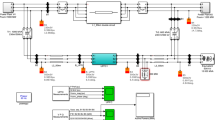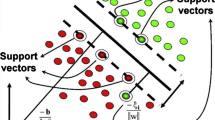Abstract
Loss of Excitation (LOE) is the most considerable fault in Synchronous generators since it affects both the generators and power network. The traditional protection method for LOE is based on impedance trajectory of the machine with negative offset mho relay. Meanwhile the traditional method experiences malfunctions and speed dip in LOE detection. This paper presents machine learning approach to detect LOE fault as well as classification logic to discriminate LOE fault from power swing conditions due to Line fault. This paper utilizes Hotelling’s-T2 statistical method to calculate Hotelling’s-T2 based Fault Indices (HT2-FI) for fault detection and Support Vector Machine (SVM) for classification. The time series data of electrical quantities such as Terminal voltage and Reactive Power of the generator are extracted from simulated Single Machine Infinite Bus test system and used as input data. These data involved in calculation of HT2-FI and in development of classification logic. The proposed method is simulated and verified for complete, partial LOE conditions and power swing conditions. Simulation outcomes depict the remarkable signs of the proposed method in LOE identification from power swing. Comparative assessment also reports that the method is capable of saving time in detecting LOE.










Similar content being viewed by others
Availability of data and materials
Not Applicable.
References
IEEE Guide for AC Generator Protection, IEEE Std C37.102™ (2006)
Pierre CRS (1985) Loss-of-excitation protection for synchronous generators on isolated systems. IEEE Trans Ind Appl Ia–21(1):81–98
Reimert D (2006) Protective relaying for power generation systems, 1st edn. CRC Press, Taylor & Francis, Boca Raton, London
Mason CR (1949) A new loss-of-excitation relay for synchronous generators. Trans Am Inst Electr Eng 68(2):1240–1245. https://doi.org/10.1109/T-AIEE.1949.5060079
Berdy J (1975) Loss of excitation protection for modern synchronous generators. IEEE Trans Power Appar Syst 94(5):1457–1463. https://doi.org/10.1109/T-PAS.1975.31987
Tambay SR, Paithankar YG (2005) A new adaptive loss of excitation relay augmented by rate of change of reactance. IEEE Power Eng Soc Gen Meet 2:1831–1835. https://doi.org/10.1109/PES.2005.1489421
Liu Y, Wang Z, Zheng T, Tu L, Su Y, Wu Z (2013) A novel adaptive loss of excitation protection criterion based on steady-state stability limit. IEEE PES Asia-Pac Power Energy Eng Conf (APPEEC) 2013:1–5. https://doi.org/10.1109/APPEEC.2013.6837140
Amini M, Davarpanah M, Sanaye-Pasand M (2015) A novel approach to detect the synchronous generator loss of excitation. IEEE Trans Power Deliv 30(3):1429–1438
Yaghobi H, Mortazavi H, Ansari K, Rajabi Mashhadi H, Khorashadi zadeh H, Borzoe H (2013) Study on application of flux linkage of synchronous generator for loss of excitation detection. Int Trans Electr Energy Syst 23:802–817. https://doi.org/10.1002/etep.1626
Yaghobi H, Mortazavi H (2015) A novel method to prevent incorrect operation of synchronous generator loss of excitation relay during and after different external faults. Int Trans Electr Energ Syst 25:1717–1735. https://doi.org/10.1002/etep.1922
Abedini M, Sanaye-Pasand M, Davarpanah M (2017) An analytical approach to detect generator loss of excitation based on internal voltage calculation. IEEE Trans Power Deliv 32(5):2329–2338. https://doi.org/10.1109/TPWRD.2016.2616386
Noroozi N, Yaghobi H, Alinejad-Beromi Y (2017) Analytical technique for synchronous generator loss-of-excitation protection. IET Gener Transm Distrib 11(9):2222–2231. https://doi.org/10.1049/iet-gtd.2016.1494
Abedini M, Sanaye-Pasand M, Davarpanah M (2017) Flux linkage estimation based loss of excitation relay for synchronous generator. IET Gener Transm Distrib 11(1):280–288. https://doi.org/10.1049/iet-gtd.2016.1009
Abedini M, Sanaye-Pasand M, Davarpanah M, Iravani R (2018) A loss-of-field detection relay based on rotor signals estimation. IEEE Trans Power Deliv 33(2):779–788. https://doi.org/10.1109/TPWRD.2017.2718839
Hasani A, Haghjoo F, Bak CL, da Silva FF (2019) A DC power-based scheme to detect loss of field in synchronous generators. In: 2019 IEEE international conference on environment and electrical engineering and 2019 IEEE industrial and commercial power systems Europe (EEEIC / I&CPS Europe), pp 1–5. https://doi.org/10.1109/EEEIC.2019.8783869
Kiaei I, Lotfifard S, Bose A (2018) Secure loss of excitation detection method for synchronous generators during power swing conditions. IEEE Trans Energy Convers 33(4):1907–1916. https://doi.org/10.1109/TEC.2018.2844198
Hasani A, Haghjoo F, da Silva FMF, Bak CL (2020) A current-based differential technique to detect loss of field in synchronous generators. IEEE Trans Power Deliv 35(2):514–522. https://doi.org/10.1109/TPWRD.2019.2910460
Morais AP, Cardoso G, Mariotto L (2010) An innovative loss-of-excitation protection based on the fuzzy inference mechanism. IEEE Trans Power Deliv 25(4):2197–2204
Sharaf AM, Lie TT (1994) ANN based pattern classification of synchronous generator stability and loss of excitation. IEEE Trans Energy Convers 9(4):753–759
Fan B, Li X, Xue P, Liu J (2009) The research UL-P of loss-of-excitation protection for generator based on the artificial neural networks. Asia-Pac Power Energy Eng Conf 2009:1–4. https://doi.org/10.1109/APPEEC.2009.4918910
Amraee T (2013) Loss-of-field detection in synchronous generators using decision tree technique. IET Gener Transm Distrib 7(9):943–954. https://doi.org/10.1049/iet-gtd.2013.0138
Krištof V, Mešter M (2017) Loss of excitation of synchronous generator. J Electr Eng 68(1):54–60. https://doi.org/10.1515/jee-2017-0007
Binnar RB, Mohale VP (2020) Analysis of static excitation system models for synchronous machine. Int J Eng Res Technol (IJERT) 09(09):62–66
Shi Z (2010) Investigation on generator loss of excitation protection in generator protection coordination
Gallas M, Morais AP, Marchesan AC, Cardoso G, Costa GB (2017) A comparative analysis of loss of excitation protection methods for synchronous generators. In: 2017 IEEE international conference on environment and electrical engineering and 2017 IEEE industrial and commercial power systems Europe (EEEIC / I&CPS Europe), pp 1–6. https://doi.org/10.1109/EEEIC.2017.7977843
Hasani A, Bak CL, da Silva FMF (2020) Performance assessment of some practical loss of excitation detection schemes employing a realistic model. Energies 13(22):5928. https://doi.org/10.3390/en13225928
Sivasamy AA, Sundan B (2015) A dynamic intrusion detection system based on multivariate Hotelling’s T2 statistics approach for network environments. Sci World J 2015:9. https://doi.org/10.1155/2015/850153
Ahsan M, Mashuri M, Kuswanto H, Prastyo DD (2018) Intrusion detection system using multivariate control chart Hotelling’s T2 based on PCA. Int J Adv Sci Eng Inf Technol 8(5):1905–1911. https://doi.org/10.18517/ijaseit.8.5.3421
Sarwar M, Mehmood F, Abid M, Khan AQ, Gul ST, Khan AS (2020) High impedance fault detection and isolation in power distribution networks using support vector machines. J King Saud Univ Eng Sci 32(8):524–535. https://doi.org/10.1016/j.jksues.2019.07.001
Hashim H, Ryan P, Clifford E (2020) A statistically based fault detection and diagnosis approach for non-residential building water distribution systems. Adv Eng Inform 46:101187. https://doi.org/10.1016/j.aei.2020.101187
Aziz K, Tripathy M, Maheshwari RP (2014) Loss of field protection of synchronous generator using SVM. Int J Electron Electr Eng 7(7):649–656
Gholami R, Fakhari N (2017) Support vector machine: principles, parameters, and applications. Chapter -27, In: Handbook of neural computation. https://doi.org/10.1016/B978-0-12-811318-9.00027-2
Raschka S (2020) Model evaluation, model selection, and algorithm selection in machine learning. arXiv: 1811.12808 [cs.LG]
Ahmed FYH, Ali YH, Siti SM (2018) Using K-fold cross validation proposed models for Spikeprop learning enhancements. Int J Eng Technol 7(4.11):145–151. https://doi.org/10.14419/ijet.v7i4.11.20790
Jack LB, Nandi A (2002) Fault detection using support vector machines and artificial neural networks augmented by genetic algorithms. Mech Syst Signal Process 16:373–390. https://doi.org/10.1006/mssp.2001.1454
Gangsar P, Tiwari R (2019) A support vector machine based fault diagnostics of Induction motors for practical situation of multi-sensor limited data case. Measurement 135:694–711. https://doi.org/10.1016/j.measurement.2018.12.011
Acknowledgments
The authors are thankful to the authorities of Thiagarajar College of Engineering, Madurai – 625015 to do this research work. This work was supported by Department of Science and Technology-Women Scientist Scheme-A fellowship scheme under Ref DST–WOS-A File No: SR/WOS-A/ET-9/2018 (2019-2022).
Funding
This work was supported by Department of Science and Technology-Women Scientist Scheme-A fellowship scheme under Ref DST–WOS-A File No: SR/WOS-A/ET-9/2018 (2019–2022).
Author information
Authors and Affiliations
Contributions
HR: Problem identification and methodology has been formulated. Entire simulation work was carried out. Analysis and interpretation of results was performed. Draft Manuscript preparation was done. GM: Review of the research work and verification of results has been done. Manuscript review and correction was performed. HR and GM: Final version of the manuscript has been reviewed for submission.
Corresponding author
Ethics declarations
Conflict of interest
The authors declare that there is no competing interests with this manuscript.
Ethical approval
Not Applicable.
Additional information
Publisher's Note
Springer Nature remains neutral with regard to jurisdictional claims in published maps and institutional affiliations.
Appendix
Appendix
SMIB System Details.
Generator | Transformer | Transmission Line | Loads |
|---|---|---|---|
S = 187 MVA, V = 13.8 kV, f = 50 Hz, No. of Phases = 3, H = 3.7, Rs = 0.00285, Type of stator connection = star, Pole pairs = 20 | S = 250 MVA, VH = 13.8 kV, VL = 230 kV, f = 50 Hz | Length = 100 km | Load1 = 13.8 kV, Load2 = 230 kV |
Excitation System Details.
Exciter Type | Parameters |
|---|---|
IEEE Type1 system | Tr = 0.002 s, Ka = 300, Ta = 0.001 s, Ke = 1, Te = 0, Kf = 0.001, Tf = 0.1, Efmax = 11.5, Efmin = -11.5 |
Rights and permissions
Springer Nature or its licensor (e.g. a society or other partner) holds exclusive rights to this article under a publishing agreement with the author(s) or other rightsholder(s); author self-archiving of the accepted manuscript version of this article is solely governed by the terms of such publishing agreement and applicable law.
About this article
Cite this article
Ramadoss, H., Muthiah, G. Machine learning approach to differentiate excitation failure in synchronous generators from power swing. Electr Eng 105, 2041–2054 (2023). https://doi.org/10.1007/s00202-023-01784-9
Received:
Accepted:
Published:
Issue Date:
DOI: https://doi.org/10.1007/s00202-023-01784-9




